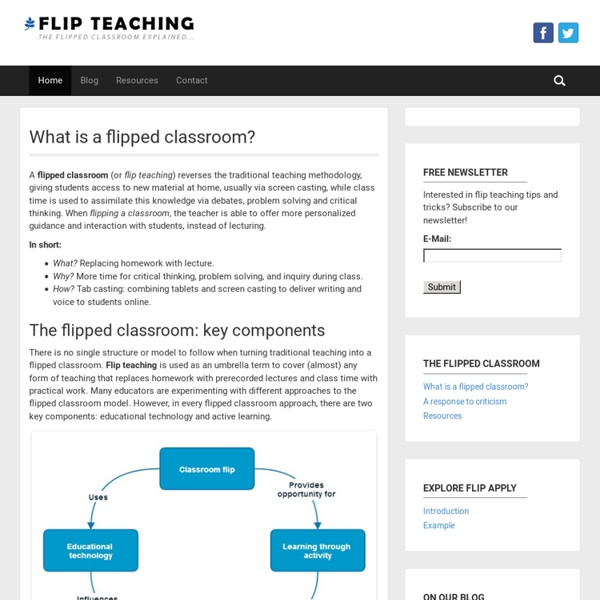



8 Educational Apps To Create Digital Portfolios by Jennifer Rita Nichols, TeachThought Intern Digital portfolios are becoming increasingly popular in classrooms across North America. School administration, teachers, parents, and students are all recognizing the benefits of this amazing tool.
Flipping the Classroom 4/27/2012 By: Teachers from around the world have adopted the flipped classroom model and are using it to teach a variety of courses to students of all ages. In the excerpt below from the book, Flip Your Classroom (©2012, ISTE® International Society for Technology in Education and ASCD), authors Jonathan Bergmann and Aaron Sams outline reasons why educators should consider this model. Flipping speaks the language of today’s students. Today’s students grew up with Internet access, YouTube, Facebook, MySpace, and a host of other digital resources.
Should You Flip Your Classroom? At its core, "flipped instruction" refers to moving aspects of teaching out of the classroom and into the homework space. With the advent of new technologies, specifically the ability to record digitally annotated and narrated screencasts, instructional videos have become a common medium in the flipped classroom. Although not limited to videos, a flipped classroom most often harnesses different forms of instructional video published online for students. Goal of Flipped Class Videos: Content Delivery or Skill Development? It recently occurred to me that since I began flipping my world history course in January, each of my screencast lectures have had one overarching goal: content delivery. This has proven tremendously useful and the early results, considering both assessment scores and student feedback, are encouraging. Transitioning some of my direct instruction (content delivery through lecture) to video has helped students understand some of the major events and themes from world history, but I realized what I should shift my focus towards: building social studies skills! Since most of our class time is now spent working on such skills, I now have a better understanding of their ability to engage in such learning experiences. In sum, I overestimated many of their abilities.
Marketing - Western Michigan Personal narrative plays an important role in Mike Garver’s teaching style. Garver, a professor of marketing at Central Michigan University, often uses anecdotes from his own life in his lectures, according to one of his students. “It’s a good way to, in his words, ‘Put a movie in your mind,’ ” says Mike Hoover, a senior at Central Michigan, who is currently taking Garver’s course in market research.
To Flip Or Not Flip? To flip or not to flip? That is not the essential question. In assessing the optimal classroom dynamics, I would argue that we need to take a good look at what our classrooms look like right now, what activities our students gain the most from, what we wished we had more time for, and what things about our class we wish we could eliminate. Do I flip: yes. Would I recommend it: enthusiastically. But let’s start by rewinding for a minute, to my 2009 AP Calculus class.
Part 1: Flipping The Classroom? … 12 Resources To Keep You On Your Feet Welcome to another post rich in resources. If you have come here looking for links that will guide you to videos and multimedia to use in a Flipped Classroom that is coming in a future post. Perhaps you have tried a little Flip of your own and want to learn more. If you are beginning to investigate what a Flipped Classroom is, with the thought of possibly trying some kind of Flip yourself… then this is also the right place.
Mr. Driscoll's Class Wiki - Flipping the Class | THE BASICS | Flipped Class In Action | | Getting Started | Student Access | | Flipped Class Resources Welcome to today's professional development session on "flipping the class!" Below is a brief intro video (also a sample screencast...) What is a "flipped class?" First, it is not (I repeat NOT) simply having students watch Khan Academy videos at school.
The Flipped Classroom Model: A Full Picture Due to Khan Academy’s popularity, the idea of the flipped classroom has gained press and credibility within education circles. Briefly, the Flipped Classroom as described by Jonathan Martin is: Flip your instruction so that students watch and listen to your lectures… for homework, and then use your precious class-time for what previously, often, was done in homework: tackling difficult problems, working in groups, researching, collaborating, crafting and creating. Classrooms become laboratories or studios, and yet content delivery is preserved.